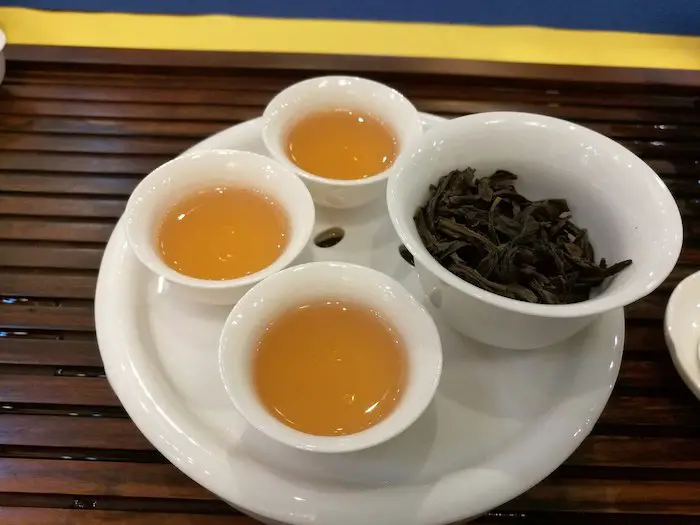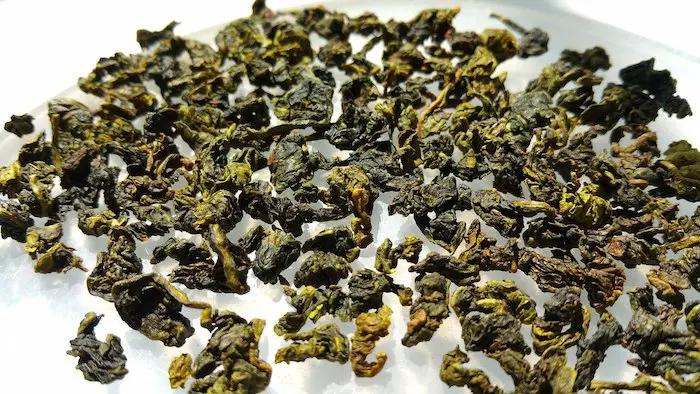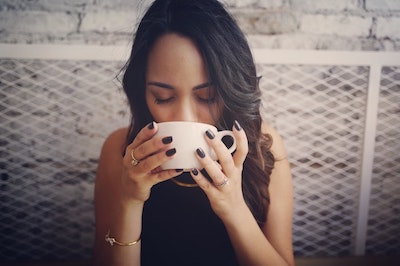We are reader supported. When you purchase through links on our site, we may earn an affiliate commission. Also, as an Amazon affiliate, we earn from qualifying purchases.

In the wonderful world of teas there are many types originating from various locations. All of which are unique on their own. Black and green teas are very popular, and most people can tell the difference between them, as their names give away at least what they may look like. But there is one that stands alone as being ancient and still mysterious to new tea drinkers just by its name alone: oolong.
While black and green teas are easy to explain, oolong can take a little longer to fully understand. Some people are unaware that it is in its own category of tea. Because of this, many people still don’t know what real oolong tea tastes like, and may be hesitant to try it out.
What does oolong tea taste like? The particular flavor of oolong tea changes vastly depending on a variety of factors, so no two oolong teas taste exactly the same. They are typically categorized by similar flavor groups, such as: toasty and woodsy, sweet and fruity, or floral and green to almost grassy. They all have complex and interesting aromas. Not only that, but each tea type can also be light or full bodied in their flavor as well.
Interested in learning more about oolong, a special type of tea? Lucky for you, I’ve collected a wealth of information to help anyone new to, or even those familiar with, oolong who wants to learn more.
Contents
What is Oolong tea?
Oolong tea’s literal translation is “black dragon tea”. It refers to a traditional type of tea thought to be originally native to the Fujian province of China, but there are other iterations on possible first locations. The big, beautiful, mountainous terrain and unique climate that it is grown in is the perfect place for oolong tea cultivation and production. Its use is believed to be dated back all the way to ancient times. Oolong tea is shipped all across the globe and is enjoyed by many for its full bodied and unique flavors.
Like a lot of teas out there, oolong comes from the branches, leaves, and buds of the camellia sinesis plant. The changes in taste, color, and shape all come from a wide variety of factors. These factors include: location it was grown, how much water and sun it got, type of soil, how long it was left to oxidize, and how it was handled, as well as a multitude of other factors. It can even change vastly because of elevation!
And while oolong tea typically only comes in an either rolled ball or long and curly shape, it can range in color from practically green, to greenish-brown, to a deep and rich black. The varying in coloration comes from how oxidized the leaves are allowed to get. The more oxidized, the deeper the color. The less oxidized, the lighter the color. Oolong tea is close to black tea in terms of having it get oxidized, though it is typically not allowed to get as oxidized as black tea tends to be and the process is much more extravagant and involved for oolong.
The making of oolong tea is probably the most in-depth and intensive tea making process out there, which really sets it apart as a labor of love. But all of that hard work really pays off when you finally take that first wonderful sip of freshly brewed oolong tea and feel as if you have been transported to the very hills that they were carefully cultivated in.
What does Oolong tea taste like?

Oolong teas are in their own category, much like black or green teas are in theirs. Oolong tea comes in a huge variety of flavors, as oolong isn’t just the name of one flavor of tea, but is actually a whole spectrum of types. Think of oolong teas like a rainbow of flavors!
The specific flavor of each tea you may get often relies on a whole slew of things, such as where they came from, how oxidized they were allowed to get, and even the technique which they were handled in. Wow!
With so many possible outcomes for flavors, it’s no wonder people are confused as they are about what flavor oolong really is. To make it a little easier to understand where they land flavor-wise and what to expect, let’s look at some facts about the flavor of oolong tea.
Sweet and Toasty
Oolong teas tend to lean mostly into the sweet, toasty, flowery, to an almost but not quite grassy flavor. All of these flavors can also be either mild or strong, but never overpowering if brewed correctly.
Oxidizing Matters
Generally speaking, the greener looking the oolong is, the less time it had to oxidize and thus these tend to taste milder and a little closer to green teas. Even so, they end up with more complex aromas and fresher flavors as well as a semi-sweet aftertaste. And unlike most green teas, oolong should never taste full-on grassy.
On the other hand, the darker the oolong is the longer it had to oxidize, and thus these tend to taste closer to black teas. They have a similar astringency but with a nice mild roasted or toasty taste. They also have the wonderful scent of fruits and honey. Unlike black teas though, oolong isn’t typically allowed to get quite as dark, so the flavors are less intense as black teas tend to get.
It’s Not Your Typical Tea!
There has also been some confusion that oolong tastes very much like the general flavors of green tea’s grassy and earthy tones. Yet, according to tea experts and enthusiasts alike, oolong tea should not taste just like green teas. Usually, the greener oolongs do tend to exhibit a similar flavor to certain green teas, but if oolong starts to taste nearly identical to green tea then it has either been stored or prepared incorrectly. Still okay to drink, note that the flavor won’t be exactly what it is supposed to be!
Somewhere In-Between
If you’ve ever tried green tea and found that the flavors were too mellow, grassy, and relaxed, or that black tea tended to be too bitter, astringent, and strong, then it can help to think of oolong tea as a nice balance of those two. There are even oolongs that are between the extreme greenest and blackest oolong colors, and these tend to exhibit the smooth and mild flavors of green tea without the grassiness, as well as the toastiness and full-bodied flavors of black tea without the full drying sensation.
With so many different types of oolong out there, you’re bound to find a new favorite. So, go out there and explore!
Is Oolong tea good for you?
There is a lot of misinformation about certain types of tea, some even so bold as to claim to cure all that may ail you. While tea can’t really become the one true elixir of healing, some types of tea do have health benefits. Chamomile, for example, is great when you’re sick, lavender is said to relax, and mint teas are soothing to a sore throat.
So, what about oolong? Does it possess any nice benefits? Aside from tasting delicious, of course.
The positive
Oolong tea doesn’t just taste and look like a mix between both black and green teas, it also is in the unique position of having the benefits of both as well.
Like black and green tea, oolong has numerous helpful vitamins, minerals, and sometimes even amino acids in each cup. While the type and amount are very much specific to the kind of oolong you have, generally speaking, oolong can have these: fluoride, potassium, magnesium, niacin, sodium, manganese, the amino acid theanine (which is typically what makes oolong tea feel relaxing), and more.
Most teas, including oolong, also have special antioxidants. These are usually called tea polyphenols. Some of these are: thearubigins, theaflavins, and EGCG. These are considered to be responsible for quite a few of oolong’s health benefits.
Among black, green, and oolong’s long list of potential benefits, they have also been linked to: improved bone, brain, heart, and dental health, as well as boosting your metabolism. It may even help to protect against type 2 diabetes and certain cancers.
The negative
While multiple studies have linked to slightly better health when drinking a moderate amount of tea daily, most studies are done with black and green tea rather than oolong. Also keep in mind this could vary from person to person, and tea should not be used to diagnose or treat any current or future symptoms.
Be sure to also be wary that a lot of oolongs have some caffeine in them, so anyone who has a caffeine sensitivity should be wary not to drink too much. Even if you don’t have a caffeine sensitivity, you should be sure to not drink oolong before bed, as this may cause restlessness. The good news is that, generally speaking, a cup of tea does not come close to the caffeine content of the same amount of coffee.
While more study is needed to get the full picture on whether or not oolong specifically can help fight off problems and boost your overall health, what we can say for certainty that oolong is delicious.
How much caffeine does oolong have?

Typically, the amount of caffeine a tea has is determined by how long the tea was left to oxidize. This is why black teas have such high caffeine content when compared to green teas. The same principal is applied to oolong, as well. The darker your oolong, the more likely it has a higher caffeine content.
While I can’t tell you exactly how much caffeine your oolong will have, I can offer you an estimate.
Oolong leaning closer to the green end of the scale can have about 30 to 37 milligrams in an 8 oz serving. Oolong closer to the black end of the spectrum tends to have approximately 49 to 55 milligrams per 8 oz serving.
For comparison, the same amount of black coffee (8 oz cup) can have anywhere from 95 to 200 milligrams. That’s a lot of caffeine!
While I’ve provided a pretty good estimate here to help you, for a more accurate reading always be sure to check your oolong’s package to see what they say about your specific kind.
What is the proper way to prepare Oolong tea?
Tea may be wonderful and can taste like a dream, but it’s also very picky with how it needs to be prepared. If you prepare any teas incorrectly, you run the risk of turning your tasty beverage into a bitter and unsatisfying liquid or a practically flavorless cup of water with extra steps.
Since oolong tea isn’t a black tea or a green tea, the steep time depends on the type you get. You don’t need to let it steep for very long or very hot at all. Finding the perfect balance between too long, too short, and just right isn’t as hard as one may think, however. By following these simple instructions you’re well on your way to making the perfect cup of oolong tea every time!
Generally speaking, oolong teas (see Amazon) perform best when the water is at 180 to 200 degrees Fahrenheit (82 to 93 degrees Celsius). Be careful not to have the water too hot, or you’ll end up with some weird, bitterness that tastes like someone’s ear. If your water is not hot enough you won’t extract all the flavors properly, if at all, and it will probably taste like you wanted a glass of water but poured it into a glass that was previously used for tea. AKA: highly under-extracted.
Make sure to leave your tea steeping for somewhere around 2 to 4 minutes, and take it out when it’s done. This is a generalization though, so be sure to check the container that your tea comes in or your tea dealer to get the most accurate brew times.
Leaving the tea leaves to sit too long will once again make it taste bitter and less palatable, and taking the leaves out too soon will leave you with a practically flavorless cup of hot water. Neither of which are befit of a tea as majestic as oolong!
Can you add sweeteners to oolong tea?
While traditionally oolong tea is served without any milk, sugar, honey, etc., sweeteners or milk can sometimes be used sparingly to sweeten up the tea. Doing this is not super common though, as this type of tea is typically consumed as-is to really help you to appreciate the full and unique flavor profile it offers.
However, this information can be taken with a grain of salt (unlike the tea, as that would be kind of gross). If you’re just looking to enjoy your own tea at home and relax, you can always feel free to add whatever the heck you want to it. But be warned, the darker types of oolongs tend to take more additions such as sugar or milk without losing too much of the flavor profile, but the lighter ones could become easily overpowered by such additions in excess. If you must add something, try to do so little by little and taste along the way.
While adding anything to the tea is not how it is consumed traditionally, doing so also isn’t forbidden and the choice is yours.
Related Questions
Can you steep your tea in an electric kettle?
As a general rule for electric kettles, you really should not be putting anything into them that isn’t water putting anything other than water inside of a kettle runs the risk of burning on to the kettle, staining, or leeching the flavor into the kettle. Tea may not seem like ti could do any of these things, but it very well could happen, so it’s best not to try.
See Also:
Does Matcha Powder Expire? The Lifespan of Matcha Powder
Does Sencha Tea have Caffeine? Read This First!
Does Matcha Stain Your Teeth? Read This First!

